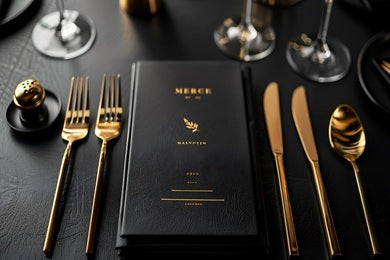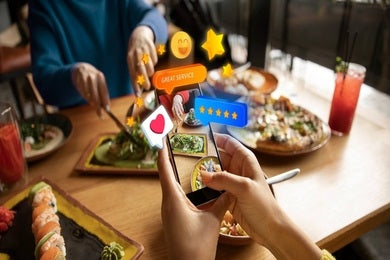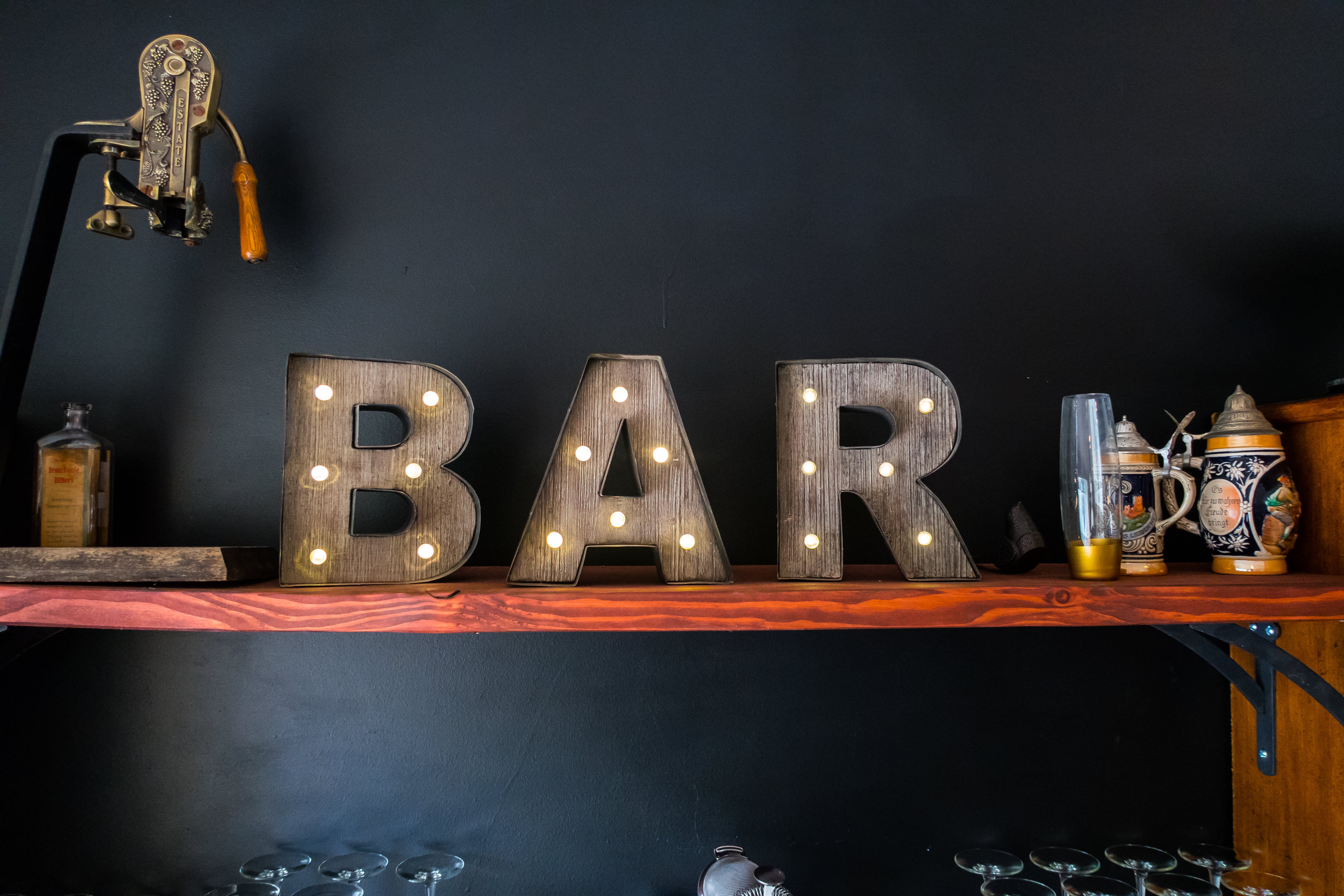
Fine Dining Menu Tips for Your Restaurant
Your fine dining menu serves as the first handshake between your restaurant and discerning guests. This single document wields extraordinary power-steering customer choices, communicating your culinary philosophy, and directly impacting revenue streams. Restaurant owners who master menu creation discover they possess a marketing weapon that works around the clock.
Building an exceptional upscale menu requires both creative vision and calculated strategy. Each element demands careful consideration, from typography choices to pricing psychology. The difference between amateur and professional menu design often determines success or failure for high-end establishments.
What Makes Fine Dining Menus Different
The Sophistication Factor
Fine dining menus distinguish themselves through sophistication and intentionality. Unlike casual dining counterparts, these menus tell stories. They showcase culinary artistry while justifying premium pricing through elegant presentation and strategic content organization.
Quality Materials Matter
The most successful establishments understand their menu represents an investment, not an expense. Fine dining restaurants typically opt for a premium menu paper option, such as synthetic, for their fine dining menu printing needs, which is a premium stock at 14 pt. Quality materials signal value before customers even read your offerings.
Strategic Organization Approaches
Professional kitchens develop unique approaches to menu structure. Some organize by cooking technique, while others by ingredient origin. The key lies in creating a logical progression that enhances the dining journey rather than confusing guests with unnecessary complexity.
Typography Secrets That Drive Sales
Font Selection Psychology
Font selection speaks volumes before customers read a single word. Serif fonts evoke tradition and elegance-perfect for established steakhouses or classical French restaurants. Sans-serif options communicate modern sophistication, ideal for contemporary American cuisine or fusion concepts.
Readability Requirements
The smallest size you should use is 20-30 points. Always print a prototype of your menu and have a few friends or colleagues read it to ensure that the font size, type, and color are legible.
Testing Under Real Conditions
Smart restaurateurs test readability under their actual dining room lighting. What looks clear under bright office fluorescents may become illegible in romantic candlelit settings. Print samples and evaluate them at various tables during different times of day.
Creating Visual Hierarchy
Hierarchy creates visual flow. Section headers should dominate, followed by dish names in medium size, with descriptions appearing in smaller yet readable text. This progression guides eyes naturally through your offerings while highlighting profitable items.

The Psychology of White Space
The Power of Empty Space
Empty space commands respect. Studies show that good use of white space improves reader comprehension by up to 30%. Cramped menus overwhelm customers, while generous spacing suggests luxury and careful curation.
Framing Premium Items
Consider how white space frames your signature dishes. Premium steakhouses often feature substantial margins around their highest-priced cuts, creating visual importance that justifies the cost. This technique works equally well for chef specialties or seasonal features.
Preventing Decision Fatigue
Professional designers know white space prevents decision fatigue. When customers face overwhelming choices, they default to familiar options rather than exploring profitable specialties. Strategic spacing reduces cognitive load and encourages adventurous ordering.
Color Psychology for Appetite Enhancement
Color Choices That Influence Spending
Color choices influence both appetite and spending patterns. Deep burgundies and rich golds suggest opulence, while crisp blacks and whites communicate precision and cleanliness. Earth tones create warmth and comfort, encouraging longer stays and additional courses.
Removing Financial Barriers
Dollar signs trigger negative associations about spending money, so omit them altogether. Color can also affect pricing perception. Studies reveal that removing currency symbols increases average order values by creating psychological distance from the transaction.
Brand Harmony Requirements
Brand consistency requires color harmony between your menu and the interior of your restaurant. Clashing palettes create subconscious discomfort that may drive customers away before they realize why they feel unsettled.
Strategic Item Placement Using Eye Movement Science
The Golden Triangle Theory
Some menu engineering specialists say that when reading a menu, our eyes typically start in the middle of the page, then move to the top right, and then to the top left, referred to as the Golden Triangle. Smart operators position their most profitable dishes within these prime locations.
Research Challenges Traditional Assumptions
However, recent research challenges traditional assumptions. According to a Korean research study in the Journal of Global Business and Technology, a third of diners are more likely to order the first item they see. A San Francisco State study suggests that guests read menus like a book, starting at the top left.
Data-Driven Placement Decisions
The solution? Test both approaches with your specific customer base. Track sales data for featured items placed in different menu positions over several weeks. Let actual purchasing behavior guide your final layout decisions rather than relying solely on theoretical models.
Price Anchoring Strategies
Price anchoring works exceptionally well for fine dining restaurant menus. Sometimes, it's recommended that the highest-priced items be placed at the top of every section. Doing this makes everything below the highest price items look more affordable. This psychological technique makes mid-range options appear reasonable by comparison.
Crafting Irresistible Menu Descriptions
Multi-Sensory Writing Techniques
Effective food writing engages multiple senses simultaneously. Describe textures, aromas, and cooking methods rather than simply listing ingredients. "Pan-seared duck breast" becomes "Crispy-skinned duck breast with five-spice crust, served over forbidden black rice with cherry gastrique."
The Power of Storytelling
Storytelling elevates simple dishes into memorable experiences. Share ingredient origins, preparation techniques, or cultural inspirations. Customers pay premium prices for narratives, not just nutrients.
Strategic Naming Conventions
The name you choose for each dish should direct the diner's attention to a particular aspect of that dish, whether it's an ingredient, a texture, a feeling, or a flavor. Strategic naming influences ordering patterns and allows higher pricing for identical ingredients prepared differently.
Local Sourcing Stories
Local sourcing stories justify premium pricing while building community connections. "Grass-fed beef from Johnson Family Farm" commands higher prices than generic "beef tenderloin," while supporting regional agriculture.
Profitable Menu Engineering Strategies
The 109-Second Rule
The average diner spends 109 seconds studying a menu, and menu engineering makes that time as productive as possible for your business. Professional menu engineers categorize items into four distinct groups based on popularity and profitability.
The Four-Category System
Stars represent high-profit, high-popularity items that deserve prominent placement and active promotion. Puzzles offer high profits but low popularity-these need better descriptions or repositioning. Plowhorses sell well but generate thin margins, requiring cost reduction or price increases. Dogs drag down overall profitability and should be eliminated or completely redesigned.
Regular Performance Analysis
Regular analysis prevents stagnation. Monthly reviews help identify shifting patterns in customer preferences and seasonal fluctuations in ingredient costs. Successful restaurants adapt quickly rather than clinging to underperforming items based on personal attachment or tradition.
Current Fine Dining Menu Examples and Trends
Classic Dishes That Endure
From succulent beef wellington to delicate seared scallops, rich truffle risotto to luxurious foie gras, hearty lobster bisque to tangy duck à l'orange, and the ever-classic rack of lamb, these dishes are a testament to the gastronomic delights that fine dining has to offer.
Modern Wellington Interpretations
Beef Wellington is a classic British dish that has gained global popularity in fine dining establishments. Modern interpretations incorporate local ingredients while respecting traditional techniques. Some chefs substitute wild mushroom duxelles with regional varieties or wrap the beef in locally-sourced pancetta instead of traditional prosciutto.
Truffle Risotto Variations
Truffle risotto is a dish that exudes luxury and sophistication. The combination of creamy risotto and aromatic truffles creates an indulgent dish that is popular among fine dining enthusiasts. Smart operators offer multiple truffle preparations at various price points, ranging from truffle oil finishing to fresh, shaved truffles for special occasions.
Contemporary Appetizer Trends
Contemporary appetizer trends favor smaller, shareable plates that encourage wine pairings and extended dining experiences. Charcuterie boards, house-made terrines, and seasonal crudo preparations enable kitchens to showcase multiple skills while increasing per-guest totals.

Building an Exceptional Fine Dining Beverages Menu
Wine Program Curation
Wine programs require careful curation, striking a balance between quality, variety, and profitability. The best food and drink pairings depend on various factors, including flavor profiles, textures, and the occasion. For example, rich and savory dishes, such as steak, often pair well with full-bodied red wines, while lighter fare, like seafood, complements crisp white wines or sparkling varieties.
Pairing Menu Strategy
Highlighting food and drink pairing ideas on your menu is one way to increase profits and enhance your service. Suggested pairings increase average tickets while demonstrating staff expertise and enhancing guest satisfaction.
Craft Cocktail Excellence
Craft cocktails deserve equal attention to food offerings. Craft cocktails are a strong selling point in every fine dining setting. Seasonal cocktail menus featuring fresh ingredients create a sense of urgency and justify premium pricing, while showcasing the bartender's creativity.
Creative Licensing Solutions
French brasserie-style restaurants are rarely known for their cocktails, and without a full liquor license, it was hard to forge a menu at San Francisco's Nico. Beverage Director Maz Naba created a program by crafting his own "spirits" from a vermouth base-bourbon, gin, tequila, mezcal, rum, crème de violette, curaçao, and others. Creative solutions overcome licensing limitations while maintaining beverage program excellence.
Sophisticated Non-Alcoholic Options
Non-alcoholic offerings require equal sophistication. House-made sodas, artisanal waters, and complex mocktails serve designated drivers and health-conscious diners while maintaining profit margins comparable to alcoholic beverages.
Physical Menu Presentation with KyivWorkshop Solutions
Premium Cover Materials
Menu presentation begins before customers read their first item. Restaurant menu covers communicate quality expectations and brand values through material choices and design execution. KyivWorkshop offers sophisticated options that enhance perceived value while protecting your investment.
Leather Cover Advantages
Leather covers suggest timeless elegance and durability. Genuine leather develops beautiful patina over time, while high-quality synthetic alternatives provide easier maintenance without sacrificing appearance. Embossed logos and foil stamping create memorable brand touchpoints that reinforce your restaurant's identity.
Natural Wood Elements
Wood accents bring natural warmth to modern dining spaces. Sustainable hardwood options appeal to environmentally-conscious diners while providing a unique texture that sets your establishment apart from competitors using generic plastic covers.
Menu Size Optimization
Menu size impacts customer experience. Standard letter-size formats feel familiar to Americans, while square formats create a modern appeal. Measure the smallest tables to ensure comfortable opening without crowding glassware.
Menu Boards for Dynamic Operations
Flexible Display Solutions
Restaurants with frequently changing offerings benefit from flexible menu boards that accommodate updates without reprinting costs. Chalkboards provide artisanal appeal for daily specials, while magnetic systems allow quick item swaps during busy service periods.
Digital Display Benefits
Digital displays are ideal for tech-forward establishments that frequently change menus or offer dynamic pricing. LED boards reduce long-term printing costs while allowing instant updates for sold-out items or last-minute additions.
Framed Display Applications
Framed displays work well for fixed sections, such as wine lists or dessert offerings, that change infrequently. Quality frames suggest permanence and importance while protecting printed materials from wear and damage.

Creative Menu Board Ideas That Build Brand Recognition
Innovation for Differentiation
Innovation distinguishes memorable restaurants from those that are forgettable. Seasonal rotation systems using interchangeable components allow frequent updates while maintaining consistent branding and presentation quality.
Interactive Digital Elements
Interactive elements, such as QR codes linking to chef videos or ingredient sourcing stories, enhance engagement without cluttering the printed space. These digital connections particularly appeal to younger demographics while providing unlimited space for detailed information expansion.
Artistic Installation Concepts
Artistic installations that double as menu displays create Instagram-worthy moments, generating free social media marketing. Collaborate with local artists to create unique pieces that reflect your restaurant's personality while serving functional purposes.
Seasonal Menu Strategy for Sustained Profitability
Seasonal Transition Benefits
Seasonal transitions help maintain customer interest while effectively managing food costs. The Seasonal Menu features dishes made with the freshest ingredients of the season (for example, the freshest spring asparagus or autumn mushrooms). Smart timing prevents ingredient costs from eroding profit margins while showcasing peak flavors.
Spring Menu Focus
Spring menus celebrate renewal with tender vegetables, fresh herbs, and lighter preparations that encourage outdoor dining and wine consumption. Summer offerings focus on raw preparations, grilled items, and refreshing beverages that suit warmer weather and extended daylight hours.
Fall and Winter Strategies
Fall transitions introduce heartier flavors, warming spices, and comfort food elevations that encourage longer dining experiences and higher wine sales. Winter menus feature rich, satisfying preparations using preserved and stored ingredients that justify higher pricing during slower periods.
Limited-Time Offering Strategy
Limited-time offerings create a sense of urgency while testing new concepts. Customers love the idea of trying something only available for a short time, and it encourages them to visit your restaurant more often. Track performance carefully to identify items worthy of permanent menu placement.
Technology Integration for Modern Fine Dining
Digital Enhancement Approach
Digital solutions enhance rather than replace traditional menu presentation. QR codes provide instant access to updated menus, detailed allergen information, and wine vintage updates without reprinting costs or space limitations.
Online Research Reality
It's a given that most people will research menus and prices online before booking a table at an expensive restaurant. Online menu accuracy becomes crucial for customer satisfaction and prevents disappointment upon arrival.
Photography Investment Value
Investing in professional food photography pays dividends across multiple marketing channels. High-quality images serve social media marketing, website presentations, and digital menu displays while maintaining consistent brand representation.
Multilingual Support
Translation capabilities accommodate international guests without separate menu printing. Digital overlays or companion apps provide multilingual support while maintaining your original design aesthetic.
Performance Tracking and Optimization
Data-Driven Decision Making
Data-driven decisions prevent costly menu mistakes and identify profit opportunities. Track individual item performance weekly to catch trends before they impact overall profitability significantly.
Revenue Analysis Methods
Average ticket analysis reveals upselling effectiveness and identifies opportunities for additional revenue. Compare pre- and post-menu change performance to measure improvement or decline in key metrics.
Customer Feedback Integration
Customer feedback provides qualitative insights that complement quantitative sales data. Monitor online reviews specifically for menu-related comments and address concerns promptly to prevent negative word-of-mouth impact.
Seasonal Performance Patterns
Seasonal comparison data helps predict future performance and optimize inventory planning. Historical patterns guide purchasing decisions and staffing adjustments that improve operational efficiency.

Future-Proofing Through Sustainability
Environmental Consciousness
Local sourcing stories and sustainable practices justify premium pricing while building community relationships. Plant-forward development captures growing demand without alienating traditional customers.
Dietary Evolution
Comprehensive allergen information and creative accommodations become competitive necessities. Health-conscious luxury represents growing segments willing to pay premium prices for nutritious yet indulgent experiences.
Success Through Strategic Menu Development
Creating exceptional fine dining menus requires striking a balance between artistic vision and business acumen. KyivWorkshop provides the physical foundation through quality restaurant menu covers, flexible menu boards, and creative menu board ideas that enhance brand presentation.
Regular evaluation keeps menus relevant and profitable. The most successful upscale menus tell compelling stories that justify premium pricing while guiding customers toward mutually beneficial choices.
Menu development never truly ends. Each iteration should build upon successes while addressing weaknesses. Consistent improvement, supported by quality presentation materials and strategic thinking, creates lasting competitive advantages that drive long-term profitability and customer loyalty.




Leave a comment
This site is protected by hCaptcha and the hCaptcha Privacy Policy and Terms of Service apply.